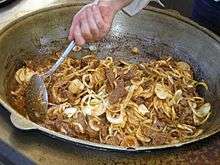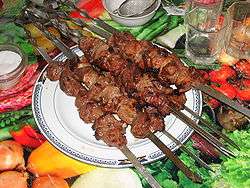List of Uzbek dishes
This is a list of notable Uzbekistani dishes and foods. Uzbek cuisine is the cuisine of Uzbekistan. The cuisine is influenced by local agriculture such as grain farming. Breads and noodles are a significant part of the cuisine, and Uzbek cuisine has been characterized as "noodle-rich".[1] Mutton is a popular variety of meat[2] due to the abundance of sheep in the country, and it used in various Uzbek dishes. Ingredients used varies by season.[2] For example, in the winter, dried fruits and vegetables, noodles and preserves are prominent, while in the summer vegetables, fruits (particularly melon) and nuts are more prominent.[2] Bread (nan, obi non) has a prominent role in Uzbek cuisine, and is influenced by pre-Islamic traditions.[2] In Uzbek culture, elders are typically served food first, as a sign of respect toward them.[3]
Uzbek dishes and foods


- Çäkçäk – unleavened dough fried in oil
- Chuchvara – a very small dumpling typical of Uzbek cuisine that is made of unleavened dough squares filled with meat.
- Chorba – one of various kinds of soup or stew found in national cuisines across the Balkans, Eastern Europe, Central Asia, and the Middle East.
- Dimlama – An Uzbek stew prepared with various combinations of meat, potatoes, onions, vegetables, and sometimes fruits. Meat (mutton or beef) and vegetables are cut into large pieces and placed in layers in a tightly sealed pot to simmer slowly in their own juices.
- Katyk – sour-milk yogurt [2]
- Lagman – lamb and noodle soup[4]
- Manti – also referred to as kaskoni,[5] dumplings filled with ground meat and onion that are steamed.[3] Typical meats used include mutton and beef.[3] Manti are sometimes prepared in a specialized steamer designed to cook them, called a mantyshnitsa.[3]
- Meats include mutton, beef, poultry, goat meat, camel meat and horse meat (such as horse meat sausage)[2]
- Melons (qovun), such as watermelon, are a prominent part of Uzbek cuisine.[3] Qovun means "melon", and may refer to a melon that has an elongated shape, which has been described as "exceptionally sweet and succulent."[3] Melons are often served as a dessert.[3]
- Naryn – a pasta dish made with fresh hand-rolled noodles and horse meat.
- Noodle-based dishes[5]
- Fried nuts and almonds[2]
- Obi Non – also called patyr[5] and nan,[2] is a bread that is a staple food in Uzbek cuisine. It is formed into large discs and cooked.[2] Tradition holds that the bread is always placed flat side up (rather than upside-down), and never cut with a knife.[2] Non is a significant part of Uzbek cuisine, and is influenced by pre-Islamic traditions.[2] It is typically prepared in tandir ovens.[3] Styles of non can vary by region.[3]
- Oshi toki – stuffed grape leaves[5]
- Plov – a pilaf dish, it is a national dish of Uzbekistan.[3][5] In Uzbek culture, it is customary for men to prepare the dish when it is served at feasts or celebrations.[2] Per tradition, plov is typically eaten without the use of utensils, with the right hand, although sometimes a spoon is used.[3]
- Rice dishes [2]
- Samsa – pastries filled with various meats and onion and cooked in a tandoor or standard oven.[3][5]
- Shakarap – a salad prepared with tomato, onion, salt and pepper[5] Some versions use a pumpkin filling during autumn.[3]
- Kabob[3][5] – meats (typically mutton or beef) grilled on a skewer or with a spit. Kabob are often sold at food stands and roadway stalls. Traditional kabob are prepared with meat only, omitting vegetables.[3]
- Shurpa – a popular soup prepared with potatoes, vegetables and meat (typically mutton)[3][5]
- Sumalak – sweet paste made entirely from germinated wheat (young wheatgrass)
- Suzma – clotted milk that is strained, forming curds[2]
- Tirit – prepared to avoid wasting dry bread, it is prepared with the broth of offals and cutting dry bread and adding ground pepper and onion.
- Yogurt soup – yogurt soup cooked with a variety of herbs, rice and sometimes chickpeas.
Beverages

- Ayran – a cold yogurt beverage mixed with salt.[6]
- Green tea (kok choy) is typically served without sugar or milk, and is often consumed in teahouses, known as choyhonas.[2]
- Soft drinks [3]
Alcoholic beverages
- Beer [3]
- Champagne [3]
- Cognac [3]
- Vodka – is the most popular alcoholic beverage, and is typically drunk straight (sans dilution or mixer).[3]
- Wine [3]
Desserts
- Halvah [5] (lavz) – in Uzbekistan and Tajikistan, soft sesame halva is made from sugar syrup, egg whites, and sesame seeds. Solid sesame halva is made from pulled sugar, repeatedly stretched to give a white color, and prepared sesame is added to the warm sugar and formed on trays.
See also
- Agriculture in Uzbekistan
- Central Asian cuisine
- Index of Uzbekistan-related articles
- Kazan (cookware)
- Outline of Uzbekistan
- Soviet cuisine
References
- ↑ Sietsema, Robert (January 19, 1999). "Two Hours Before the Maste". Village Voice. Retrieved 10 April 2014.
- 1 2 3 4 5 6 7 8 9 10 11 12 13 14 15 16 Cavendish, Marshall (2006). World and Its Peoples. Marshall Cavendish. p. 706. ISBN 0761475710.
- 1 2 3 4 5 6 7 8 9 10 11 12 13 14 15 16 17 18 19 20 21 22 23 Hanks, Reuel R. (2005). Central Asia: A Global Studies Handbook. ABC-CLIO. pp. 125–130. ISBN 1851096566.
- ↑ DK Publishing (2013). DK Eyewitness Travel Guide: Russia. Penguin. p. 282. ISBN 146541794X.
- 1 2 3 4 5 6 7 8 9 10 11 Uzbekistan Country Study Guide Volume 1 Strategic Information and Developments. Int'l Business Publications. 2013. pp. 56–57. ISBN 1438775881.
- ↑ A. Y. Tamime (ed.) (2008). Fermented Milks. John Wiley & Sons. p. 124. ISBN 9781405172387.
External links
-
 Media related to Cuisine of Uzbekistan at Wikimedia Commons
Media related to Cuisine of Uzbekistan at Wikimedia Commons

.jpg)

